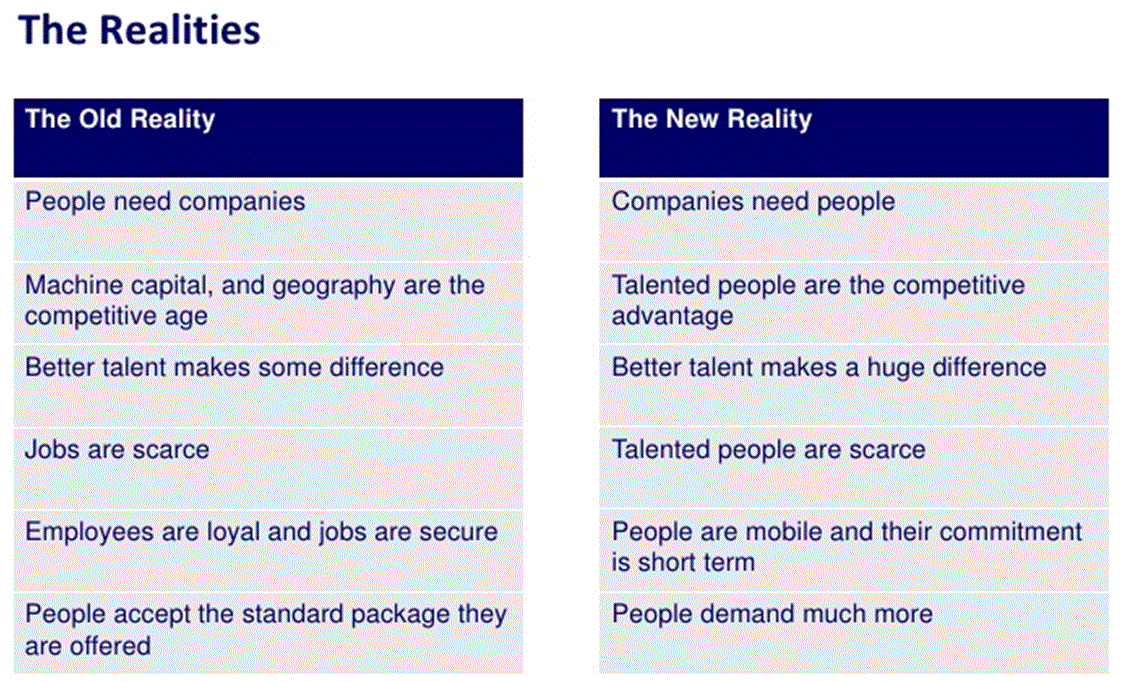PMI Part 4: What is gained through the talent triangle by individuals and organizations?
The introduction of the talent triangle has benefits for both the individual and the Organisation they work for. The team here at CUPE has long advocated that projects need more than a method to succeed. We have run project leadership courses for more than a decade and cover the supporting strategic and business management areas which specifically support projects, programmes and portfolios in addition. So now to answer the ‘what’s in it for me’ questions for both the individuals and organizations. We need to ensure that we take into account the new realities (in the table below) of managing talent. Individuals are more mobile than ever and those with superior skills are highly sought after. On the flip side organizations are not seen to be loyal to individuals and so those that are attract the most talented individuals.
As an individual it means that I will be able to submit education across a wider variety of topics to gain PDUs. If my budget is limited I am no longer put in a position where I must choose the ‘hard’ PPM topics as the softer skills and broader such as negotiation and strategic planning are now being recognized as critical skills to successfully deliver projects. I can pursue aspects which will help my career progression in terms of leadership, business acumen and strategic management. It will also result in my projects being more successful by pursing a breadth of subject matter rather than simply adding more and more depth to the same area. There will also be the recognition that anyone who has a PMI certification and has been through one CCR cycle will have more than purely the certification. They will be preferred to those who just get the certificate. Again enhancing individual career prospects.
The talent war identified by McKinsey means that organisations need to ensure that they are attractive to the most talented people. McKinsey has identified a cycle (below) to achieve an attractive place to work for the talented individuals who already achieve on all sides of the talent triangle.

The other side of this talent war is the organizational benefits. These are at least as great as for the individuals. The organizations which need the project, programme and portfolio managers will gain as well as the individuals. The research on which the talent triangle was based1 showed that high performing organizations want to see an increase in leadership and strategic and business management skills. What does that really mean for an organization? What specific skill and knowledge areas are important now? The talent triangle can provide a steer on what is important for your organization that in turn can really help the right development options to be chosen. A long term programme can be developed which will enable the talent to be grown within the organization. In turn the development opportunities within the organization will both attract and retain great individuals.
Organizations need to consider the benefits in terms of ROI, time to deliver and quality of deliverables not just attracting and retaining individuals. If talented individuals are retained within the organization there is a competitive advantage as well.2 Thus the talent triangle provides measurable benefits whether we consider job satisfaction, team harmony, customer satisfaction, making a difference to the bottom line, or delivery on time and to quality.
If you would like to understand more about how the talent triangle can benefit you or your organization contact the CUPE Team.
Sources:
1 “Project Management Between 2010+2020” (Project Management Talent Gap Report), 2013, PMI.
2 The Competitive Advantage of Effective Talent Management, 2013, PMI
http://www.mckinsey.com/insights/organization/how_multinationals_can_attract_the_talent_they_need



